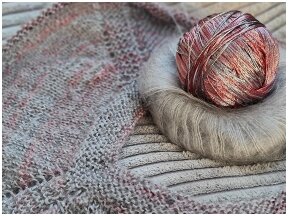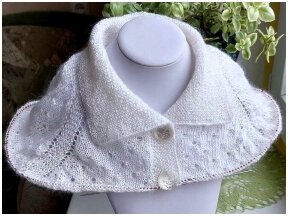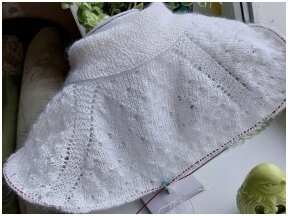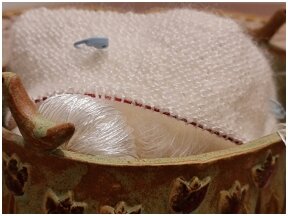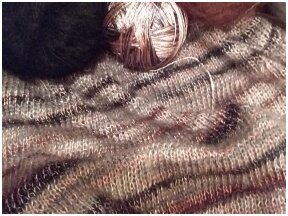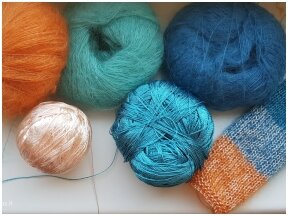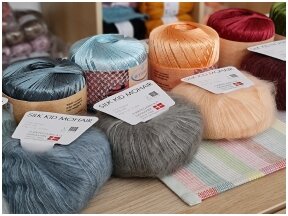Mohair and viscose knits - glistening fluffy luxury
-
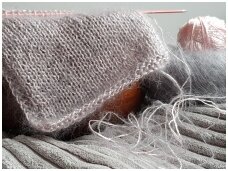
Thin mohair yarn with silk is in the basket of almost every knitter. Knitworks from mohair have taht magical effect which always facinates us. Another wonderful feature of these yarns is that they can be added to almost any other yarn to create a variety of knits. They go especially well with viscose.
What is viscose?
Ajur viscose has been on the shelves of our store for several years. For very careful crocheters, it is often suitable as a main fiber, Irish lace can be created from viscose. Not everyone can handle a pure viscose thread, but once you've made friends with it and have a clear vision of what you want to create, viscose is simply amazing! It is also great because it is of artificial origin, but still a natural fiber (extracted from cellulose, i.e. wood). So, with knits made of Ajur viscose, there will be no feeling of heat, synthetic gurgling or other unpleasant sensations that are sometimes characteristic of artificial fibers.
If not every knitter can "control" pure Ajur viscose, then by adding it to another thread, almost everyone succeeds in creating impressive knits.
How Ajur viscose "affects" our knitwear:
the first thing that always catches my eye is the sheen of viscose (not an artificial gold or silver effect, but a natural visible sheen) and this sheen is the key feature that permeates all the knits it touches. This does not mean that your knitwear will look like Christmas decorations. If you knit viscose by adding another thread, that other thread will "absorb" part of the shimmer and your knit will be very delicately decorated with a light, moderate touch of shimmering luxury;
another inseparable feature of viscose is its fall. It is a fiber with weight. It doesn't really float in the air and spin around you like a window spider. These are all properties of mohair. Viscose gives the knit weight. It makes every thread, even the lightest, more "falling", more close to the body, gives a clearer shape. Sometimes it is really necessary.
The third distinctive feature of viscose is its coolness. If another thread will more or less "warm" your knitwear, viscose definitely won't. It is a fiber that cools more than it warms. So this feature is very good in case you want to add volume to the knitwear without adding extra warmth.
Why do mohair and viscose go so well together?You know, we often want to explain everything that happens around us, we look for reasons and logical justification. But sometimes, when two good things (in this case, yarn) meet, some magic happens. First, not all knitters like to knit from one thin mohair thread. You need to choose the right needles, master the rhythm of such knitting and see its beauty. And when added to another thread, mohair often begins to give that pleasure, which later on, rarely anyone can resist. Mohera gives volume to the thin slippery viscose thread with its fluff and seems to raise it to the next level of knitting. The knitting in this case does not really become thick. It becomes, as it were, more clearly palpable. Mohair and viscose yarns perfectly complement each other, sharing their best distinctive qualities and creating a brand new luxurious unique knitwear.
How to combine mohair and viscose colors
There are two tuning methods available here:
classic - when looking for shades that are as close as possible to each other, when mohair and viscose go well together, exchange their best features, but do not play with colors. It is safe, guaranteed and the most popular method of threading. Almost 90% of the combinations sent to you are exactly like this.
creative - when an interesting combination of colors and their interplay is the main driving force. This does not mean that we have to choose without thinking, put our finger on two colors that we like and hope that they will create a miracle (although it is possible :). The guidelines for the colors you like and how to match them always remain. However, this way you can take two matching colors and create unique knits. For example, one customer combined a warm brown viscose with a smoky lilac mohair thread. And you got a fabulously beautiful knitwear! In this case, you need to allow yourself to fantasize a little and "see" the vision of the play of colors in your mind. And the result usually exceeds expectations :)
Does thin viscose only go with mohair?Not really. Although mohair creates a knit with a special magic, the sheen and weight of viscose can be added to any other yarn. Here is my example of how the viscose complemented the cotton yarn perfectly. The viscose was a soft peach 210 and the cotton roll varied from flesh/peach to coral red. The colors went very well together, in some places the viscose blended with the color of the cotton, in other places, on the contrary, it shone with its uniqueness. The cotton knit has a very beautiful fall and has been worn and much loved for several years.


